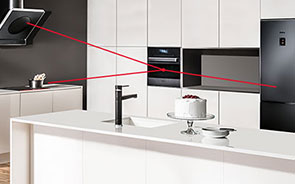There are several things that should be taken into account when planning a lighting design, including the natural light sources, furniture layout, room size and room function.
A bright kitchen
For many people a kitchen with plenty of daylight is a must. There's nothing like eating your breakfast or drinking coffee in the morning while looking out of the window. It's also important for the tops and workspaces to be well lit. Who would want to cook in a dim, murky kitchen? With the right layout of general lighting, including ceiling and spot lights, the kitchen will remain illuminated, even after dark.
While working on your kitchen lighting design, don't forget about the additional light sources in household appliances. Amica hoods feature wide-angle LED lighting that illuminates the worktops for greater comfort while cooking and to build a relaxing atmosphere for the whole kitchen.
Everything in a good light
Well-lit interiors increase our energy and inspire activity. With open-plan spaces, such as a living room with a kitchen annex, it's a good idea to define areas for specific purposes, such as cooking, dining, reading or working. Each area requires specialised types of lighting, but bear in mind that all the light sources in one room should form a harmonious whole and have a similar colour temperature. Besides the general ceiling-mounted lights (such as chandeliers, hanging lamps and halogen lights), spot lighting also plays an important role. It provides illumination for specific parts of the room which must be well-lit, such as the lounge area with its armchairs and sofa. It also goes a long way to building an intimate and relaxed atmosphere: just switch on a lamp, make some tea and lose yourself in your favourite music.
















